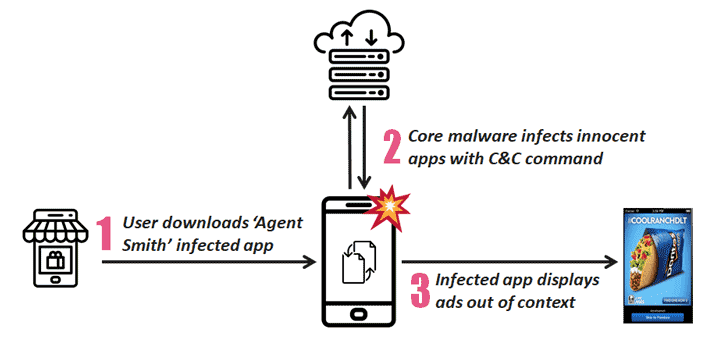New Malware Replaced Legit Android Apps With Fake Ones On 25 Million Devices
Are you sure the WhatsApp app you are using on your Android device is legitimate, even if it's working perfectly as intended?
...Or the JioTV, AppLock, HotStar, Flipkart, Opera Mini or Truecaller app—if you have installed any of these?
I'm asking this because cybersecurity researchers just yesterday revealed eye-opening details about a widespread Android malware campaign wherein attackers silently replaced installed legitimate apps with their malicious versions on nearly 25 million mobile phones.
Now the important question here is how they're doing it and why?
According to researchers at Check Point, attackers are distributing a new kind of Android malware that disguises itself as innocent-looking photo editing, adult entertainment, or gaming apps and available through widely used third-party app stores.
Dubbed Agent Smith, the malware takes advantage of multiple Android vulnerabilities, such as the Janus flaw and the Man-in-the-Disk flaw, and injects malicious code into the APK files of targeted apps installed on a compromised device and then automatically re-install/updates them without the victims' knowledge or interaction.
The malware, which researchers believe is tied to a China-based firm, has been designed for financial gain by serving malicious advertisements to victims.
Upon installation of boobytrapped apps, the Agent Smith malware leverages a three-stage infection chain and contains different modules for each step, working of which are explained below:
1.) Loader Module — The initial app distributing the malware contains a module called Loader, whose only purpose is to decrypt, extract, and run the second stage module named Core.
2.) Core Module — Once executed, the Core module communicates with the attackers' C&C server to receive a list of popular apps that needs to be targeted.
If it finds a match installed on the victim's device, the Core module tries to infect the targeted APK using the Janus vulnerability or by simply recompiling the APK with a malicious payload.
Further, to automatically install the modified APK and replace its original version without users' consent, attackers utilize a series of 1-day vulnerabilities, including man-in-the-disk attack.
3.) Boot Module — This module is included in the malicious payload that was bundled with the original app and worked the same as the Loader module. It extracts and executes a malicious payload, called the Patch module when a victim runs the modified application.
4.) Patch Module — The patch module has been designed to prevent modified applications from getting legitimate updates, which if installed, would revert all malicious changes.
6.) AdSDK Module — This is the actual payload that displays ads to the victims for financial gain and further also infects the device with other adware families.
However, the researchers warn that this modular malware could be easily adapted for far more intrusive and harmful purposes, such as stealing sensitive information—from private messages to banking credentials and much more.
Researchers initially encountered the Agent Smith malware in early 2019, which was primarily being found targeting Android devices in India (with 15 million infected devices) and other nearby Asian countries like Pakistan, Bangladesh, Indonesia, and Nepal.
However, the malware also affected a noticeable number of devices in the United States (more than 300,000 infected devices), Australia (over 140,000 infected devices) and the United Kingdom (over 135,000 infected devices).
Besides third-party app stores, researchers also found at least 11 infected apps on the Google Play Store in recent months containing malicious yet inactive Agent Smith components.
This clearly indicates that the threat actors behind this malware campaign are also trying to find a way in Google's mobile app download platform to spread their adware. Google has reportedly removed all the apps from its store.
Since Agent Smith has mostly infected users who downloaded apps from third-party app stores, users are highly recommended always to download apps from trusted app stores to mitigate the risk of infection. Also, download apps only from trusted developers.
Users are also advised to uninstall any apps they suspect may be malicious by heading on to Settings Menu, clicking Apps or Application Manager, and then Scroll to the suspected app and uninstall it.
Since the key vulnerability Agent Smith is exploiting dates back to 2017 and has already been patched, mobile app developers are recommended to implement the latest APK Signature Scheme V2 to prevent malicious apps from leveraging Android's Janus vulnerability against their apps.
...Or the JioTV, AppLock, HotStar, Flipkart, Opera Mini or Truecaller app—if you have installed any of these?
I'm asking this because cybersecurity researchers just yesterday revealed eye-opening details about a widespread Android malware campaign wherein attackers silently replaced installed legitimate apps with their malicious versions on nearly 25 million mobile phones.
Now the important question here is how they're doing it and why?
According to researchers at Check Point, attackers are distributing a new kind of Android malware that disguises itself as innocent-looking photo editing, adult entertainment, or gaming apps and available through widely used third-party app stores.
Dubbed Agent Smith, the malware takes advantage of multiple Android vulnerabilities, such as the Janus flaw and the Man-in-the-Disk flaw, and injects malicious code into the APK files of targeted apps installed on a compromised device and then automatically re-install/updates them without the victims' knowledge or interaction.
"It's not enough for this malware family to swap just one innocent application with an infected double. It does so for each and every app on the device as long as the package names are on its prey list," the researchers wrote in their report published Wednesday.
"Over time, this campaign will also infect the same device, repeatedly, with the latest malicious patches. This leads us to estimate there to be over 2.8 billion infections in total, on around 25 Million unique devices, meaning that on average, each victim would have suffered roughly 112 swaps of innocent applications."
The malware, which researchers believe is tied to a China-based firm, has been designed for financial gain by serving malicious advertisements to victims.
How Does Agent Smith Malware Work?
Upon installation of boobytrapped apps, the Agent Smith malware leverages a three-stage infection chain and contains different modules for each step, working of which are explained below:
1.) Loader Module — The initial app distributing the malware contains a module called Loader, whose only purpose is to decrypt, extract, and run the second stage module named Core.
2.) Core Module — Once executed, the Core module communicates with the attackers' C&C server to receive a list of popular apps that needs to be targeted.
If it finds a match installed on the victim's device, the Core module tries to infect the targeted APK using the Janus vulnerability or by simply recompiling the APK with a malicious payload.
Further, to automatically install the modified APK and replace its original version without users' consent, attackers utilize a series of 1-day vulnerabilities, including man-in-the-disk attack.
3.) Boot Module — This module is included in the malicious payload that was bundled with the original app and worked the same as the Loader module. It extracts and executes a malicious payload, called the Patch module when a victim runs the modified application.
4.) Patch Module — The patch module has been designed to prevent modified applications from getting legitimate updates, which if installed, would revert all malicious changes.
"While investing a lot of resources in the development of this malware, the actor behind Agent Smith does not want a real update to remove all of the changes made, so here is where the Patch module comes in to play"
"With the sole purpose of disabling automatic updates for the infected application, this module observes the update directory for the original application and removes the file once it appears."
6.) AdSDK Module — This is the actual payload that displays ads to the victims for financial gain and further also infects the device with other adware families.
However, the researchers warn that this modular malware could be easily adapted for far more intrusive and harmful purposes, such as stealing sensitive information—from private messages to banking credentials and much more.
Researchers initially encountered the Agent Smith malware in early 2019, which was primarily being found targeting Android devices in India (with 15 million infected devices) and other nearby Asian countries like Pakistan, Bangladesh, Indonesia, and Nepal.
However, the malware also affected a noticeable number of devices in the United States (more than 300,000 infected devices), Australia (over 140,000 infected devices) and the United Kingdom (over 135,000 infected devices).
Besides third-party app stores, researchers also found at least 11 infected apps on the Google Play Store in recent months containing malicious yet inactive Agent Smith components.
This clearly indicates that the threat actors behind this malware campaign are also trying to find a way in Google's mobile app download platform to spread their adware. Google has reportedly removed all the apps from its store.
Since Agent Smith has mostly infected users who downloaded apps from third-party app stores, users are highly recommended always to download apps from trusted app stores to mitigate the risk of infection. Also, download apps only from trusted developers.
Users are also advised to uninstall any apps they suspect may be malicious by heading on to Settings Menu, clicking Apps or Application Manager, and then Scroll to the suspected app and uninstall it.
Since the key vulnerability Agent Smith is exploiting dates back to 2017 and has already been patched, mobile app developers are recommended to implement the latest APK Signature Scheme V2 to prevent malicious apps from leveraging Android's Janus vulnerability against their apps.
Have something to say about this article? Comment below or share it with us on Facebook, Twitter or our LinkedIn Group.



